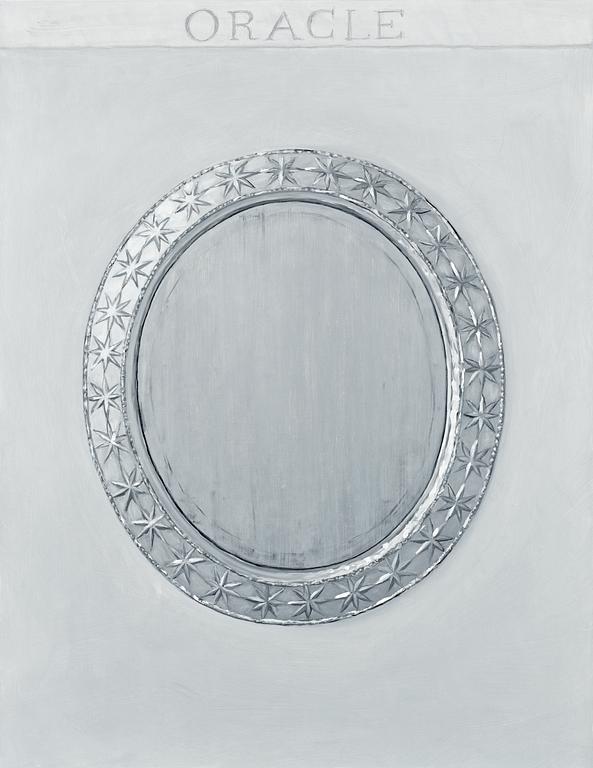Ylva Snöfrid (Ogland)
"The Oracle"
Signed Ylva Ogland and dated 2004 on verso. Canvas 88 x 68 cm.
Provenance
Fruit and Flower Deli, New York.
More information
TURNING REALITY INTO MYTHOLOGY
By Marcel Janco
Our reality is becoming more and more like fiction. Fictitious characters, pseudonyms and aliases are key siginfiers of our present moment. The practice of Ylva Ogland and her work The Oracle are connected to this reality, yet still remain deeply separated from it. What makes Ogland’s work unique is her use of mythology, or to be more precise, her attempt to turn reality into mythology – an act that perfectly suits her Scandinavian DNA and the obvious connection to the legend of Tor and Odin. The Oracle is a painting of a mirror that has been in Ogland’s family for more than four generations. The mirror was taken into great consideration by all of her ancestors, but there’s no doubt that in Ogland’s case, consideration is intertwined with representation, a central theme in her practice. Eventually, The Oracle became the leader of Fruit and Flower Deli, a project started in New York by Ogland’s husband Rodrigo Mallea Lira. In this position, The Oracle’s messages could only be accessed through the gallery’s website or through the keeper of The Oracle, namely Mallea Lira. Like the candle that burns in all Catholic churches, the depiction of the mirror was always present, even in a Flemish-like portable version, which was eventually displayed in art fair booths. The message emerging from these elements is that neither the Internet nor globalization will stop us from creating our own personal mythologies. In a field of art rooted in western, agnostic and capitalist attitudes, it is even more powerful to speak the dead language of myth, especially in a time in which having faith is taboo, even though we all believe a toilet signed “R. Mutt” is the most important artwork of the XX Century.
I mention Marcel Duchamp’s masterpiece because there is a fundamental connection between a specific moment of Duchamp’s practice and the work of Ylva Ogland. Whether fiction or mythology, Ogland’s paintings shows us that there is another possible reality lurking behind the mirror, one that we can only experience through representation. Ogland’s effect cannot be achieved through photography because the language of this medium is still too firmly rooted in functionality. When painting definitively lost the function of representing reality it became the perfect tool to represent the other reality, the one we imagine. This is why Duchamp painted Étant donnés (1946-1966) as his final major work, surprising an art world that believed he had given up art for chess 25 years earlier. The hole through which the viewer looks into Étant donnés is quite similar to the mirror represented in The Oracle. To make the connection even clearer, Ogland created a series of works and installations based on the concept of voyeurism using a peep-hole. Their biographical parallels are also interesting to note: Duchamp made Étant donnés after abandoning art for chess, whereas Ogland created The Oracle after quitting her artistic career to become a curator and the director of Tensta Konsthall in Stockholm. So what is the difference between Duchamp’s late work and Ogland’s Oracle? The radical difference is that while Étant donnés created a new reality, The Oracle reveals to us that the other reality is here, only a reflection. In other words, while Duchamp had the urge to create a parallel reality, Ogland is willing to let us discover through a mirror that fiction and reality are melted in the broth of representation. Nietzsche said: “No artist tolerates reality.” Ballard echoed him and he said: “The writer’s task is to invent the reality.” In this scenario fiction is no doubt the best form of reality.
Marcel Janco
Marcel Janco is an art writer and curator based in Turin and Cluj-Napoca, Transylvania. From June 2007 to June 2009, he worked as Associate Editor of UOVO magazine, where he curates “VIEW,” a section of the magazine in the form of an exhibition-on-paper. In 2009 he co-founded with Daria D. Pervain, Galeria Sabot, a contemporary art space in Cluj-Napoca, Transylvania, organizing “SABOT-AGE! Picture Maxxification, Cultural Digestion, and Populist Elitism in the Age of Masking Economy,” the very first appearance of the gallery in Rome during “START-UP” at ROMA – The Road of Contemporary Art. He has been recently appointed special correspondent of Archive Journal and he’s currently working on two essays: one devoted to the practice of Swedish painter Ylva Ogland, to be included in the forthcoming book about her work and one focused on collecting to be published in the next issue of Snöfrid magazine.






























